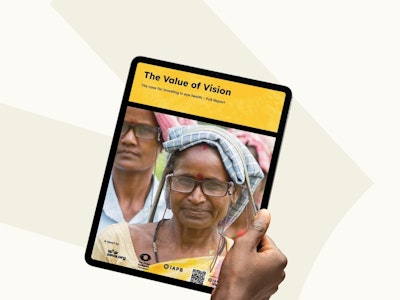
Spain
-
- No results
How many people have sight loss?
Sight loss by gender
These modelled data provide country estimates of different levels of sight loss for males and females (all ages). Hover over chart segments to view the measure for each level of sight loss, or select legend items to filter.
Currently selected
How much does sight loss cost?
Productivity loss due to poor vision per year
This research highlights the economic impact of avoidable blindness and vision impairment (ages 50-64) on productivity loss (in USD) across countries. Investing in eye health services, especially for working-age populations, can boost productivity and support economic development.
Currently selected
What progress is being made?
Eye care integration
This table presents key results from the 2030 In Sight Country Progress Survey, providing data on country-level progress toward eye health systems goals outlined in the 2030 In Sight strategy. This structured tracking of national-level indicators helps identify gaps and implementation challenges that require targeted intervention.
Currently selected
|
|
|
|---|---|
How to cite: The International Agency for the Prevention of Blindness. 2030 In Sight Country Progress Survey. Accessed via the IAPB Vision Atlas: visionatlas.iapb.org.
Diving into the details
Explore comprehensive eye health data to gain a fuller understanding of national eye health status and needs.
Demographics
Currently selected
Sight loss & causes
Magnitude of sight loss
Sight loss over time
This interactive line chart tracks changes in different levels of sight loss at country level from 1990 to 2020 (all ages). The crude prevalence and numbers are often increasing due to an ageing and growing population, and sight loss remains an urgent and increasingly important public health priority.
Customise the chart using the dropdown menus, or select legend items to filter.
Currently selected
Sight loss by age
These modelled data for the year 2020 provide country estimates of different levels of sight loss for the total population and adults aged 50+. Hover over chart segments to view the data for each level of sight loss, or select legend items to filter.
Currently selected
Sight loss by gender
These modelled data provide country estimates of different levels of sight loss for males and females (all ages). Select a measure with the drop-down menu, select legend items to filter, or hover over chart segments to view more information.
Currently selected
Causes of sight loss
These data gathered from RAAB surveys or published research studies provide the causes of different levels of sight loss for different countries. Most sight loss can be treated or prevented.
Currently selected
Status of elimination of trachoma and onchocerciasis
These data present the current status of elimination as a public health problem of two major neglected tropical diseases (NTDs) that cause preventable blindness: trachoma and onchocerciasis (river blindness).
Currently selected
How to cite: World Health Organization. Trachoma. The Global Health Observatory. Accessed via the IAPB Vision Atlas: visionatlas.iapb.org. World Health Organization. Onchocerciasis. The Global Health Observatory. Accessed via the IAPB Vision Atlas: visionatlas.iapb.org
Economics
Schooling and economic loss from uncorrected refractive error in school children
This table shows the educational and economic impact of uncorrected refractive error (URE) in school children by country. The educational impact is significant, with tens of thousands of school years lost each year in many countries. Cost-effective interventions like vision screening and eyeglasses offer long-term benefits for individual earnings and national economic growth.
Currently selected
How to cite: Dhakhwa p, et al. Better education in sight. An estimate of global learning and economic productivity losses from uncorrected refractive error in schools. (2024) Accessed via the IAPB Vision Atlas: visionatlas.iapb.org.
Productivity loss due to poor vision per year
This research highlights the economic impact of avoidable blindness and vision impairment (ages 50-64) on productivity loss (in USD) across countries. Investing in eye health services, especially for working-age populations, can boost productivity and support economic development.
Currently selected
Effective coverage
Cataract
Effective cataract surgical coverage (eCSC)
These data show key cataract surgery metrics for the selected country, cataract surgical coverage (CSC) and effective cataract surgical coverage (eCSC). The gap between CSC and eCSC indicates opportunities for improving surgical quality and post-operative care.
Currently selected
Cataract
Cataract surgical rate (CSR)
Cataract Surgical Rate (CSR) is the number of cataract operations performed per million population annually. CSR is a key indicator of a country’s capacity to address cataract-related blindness, and helps identify countries needing increased surgical services to address cataract backlogs and reduce preventable blindness.
Currently selected
Cataract
Out-of-pocket expenditure for cataract surgery
These data show the average out of pocket cost for cataract surgery, as reported through a survey completed by a key respondent in each country.
Currently selected
|
|
|
|---|---|
How to cite: The International Agency for the Prevention of Blindness. 2030 In Sight Country Progress Survey. Accessed via the IAPB Vision Atlas: visionatlas.iapb.org.
Refractive error
Effective refractive error coverage (eREC)
Effective refractive error coverage (eREC) is the proportion of people in need of refractive error services who have received services and have a good-quality outcome.
eREC data displayed is for the 6/12 threshold, crude prevalence for adults 50+.
Currently selected
How to cite: Bourne R, et al. Effective refractive error coverage in adults: a systematic review and meta-analysis of updated estimates from population-based surveys in 76 countries modelling the path towards the 2030 global target. Lancet Glob Health. 2025. Accessed via the IAPB Vision Atlas: visionatlas.iapb.org.
Refractive error
Spectacle need and use
This table presents key metrics on spectacle access and utilisation at country level. These measurements help identify gaps between vision correction needs and actual service delivery, highlighting opportunities for targeted interventions to improve access to appropriate eyewear and reduce preventable sight loss.
Currently selected
How to cite: World Health Organization. Assistive technology data portal. The Global Health Observatory. Accessed via the IAPB Vision Atlas: visionatlas.iapb.org.
Refractive error
Good quality spectacles: average out of pocket cost
These data show the average out of pocket cost for good quality spectacles, as reported through a survey completed by a key respondent in each country.
Currently selected
|
|
|
|---|---|
How to cite: The International Agency for the Prevention of Blindness. 2030 In Sight Country Progress Survey. Accessed via the IAPB Vision Atlas: visionatlas.iapb.org.
UHC Service Coverage Index
This chart presents the Universal Health Coverage (UHC) service coverage index, which measures population access to essential health services across multiple dimensions. The index serves as a key benchmark for monitoring progress toward SDG Target 3.8, which aims to achieve universal health coverage for all.
Currently selected
Eye health commitments
Eye health commitments
Eye health commitments are critical for meeting the goals of 2030 In Sight Strategy, including commitments made by diverse stakeholders. Strategic commitments are essential for translating goals into concrete action, representing one of the first steps toward sustainable improvements in eye health services.
Currently selected
|
No data available
|
How to cite: The International Agency for the Prevention of Blindness. Eye Health Commitment Tracker. Accessed via the IAPB Vision Atlas: visionatlas.iapb.org.
Market changes for spectacle access
This table maps key policy and regulatory frameworks that impact spectacle access at country level. These system-level factors can substantially influence affordability, availability, and quality of vision correction services.
Currently selected
|
|
|
|---|---|
Commitment to human rights: UN conventions ratified
This table provides data on the ratification status for three major United Nations human rights conventions that are relevant to eye health and vision care access at the country level for vulnerable populations.
Currently selected
How to cite: United Nations Human Rights Treaty Bodies. View the ratification status by country or by treaty. UN Treaty Body Database. Accessed via the IAPB Vision Atlas: https://visionatlas.iapb.org.
Eye health systems
2030 In Sight Country Progress
These data demonstrate the progress towards the eye health systems goals of the 2030 In Sight strategy, as reported through a survey completed by a key respondent in each country.
Currently selected
|
|
|
|---|---|
How to cite: The International Agency for the Prevention of Blindness. 2030 In Sight Country Progress Survey. Accessed via the IAPB Vision Atlas: visionatlas.iapb.org.
Eye health workforce
This chart shows the ophthalmic human resources at country level. The workforce density information is vital for understanding service delivery capacity, identifying personnel shortages, and informing health workforce planning to achieve sufficient coverage for population needs.
Currently selected
Workforce
Currently selected
|
|
|
|---|---|
How to cite: The International Agency for the Prevention of Blindness. 2030 In Sight Country Progress Survey. Accessed via the IAPB Vision Atlas: visionatlas.iapb.org.
Workforce
Two key workforce indicators related to vision care at the country level. This global dataset helps identify workforce capacity gaps that may impede access to essential vision services and assistive technologies.
Currently selected
How to cite: World Health Organization. Assistive technology data portal. The Global Health Observatory. Accessed via the IAPB Vision Atlas: visionatlas.iapb.org.
Rapid Assessment of Avoidable Blindness surveys
RAAB is a well-established population-based eye health survey. It assesses the prevalence and causes of vision loss and blindness among people aged 50 years+. Data from RAAB surveys are vital to generate vision loss estimates calculated by the Vision Loss Expert Group on the Vision Atlas. This table shows RAAB surveys since 2000.
Currently selected
|
No data available
|
IAPB members
IAPB member map
Select the map to show any IAPB members that have head offices in this country.
Currently selected
Featured news

China faces escalating childhood myopia crisis with projections reaching 61% by 2050

The Value of Vision: The case for investing in eye health
Explore topics

Effective coverage of refractive error care

Magnitude of sight loss













